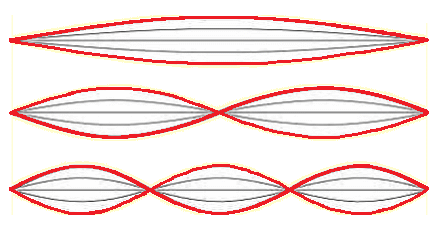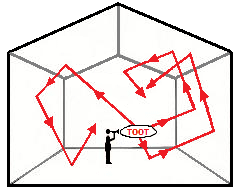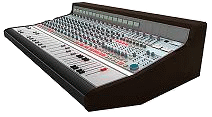
What gives a studio its sound?
Some recording studios are famous for their sound. So what goes into creating that sound? Is it the recording engineer? Is it the studio? Is it the equipment? Is it the mixing engineer? What about mastering? Well, I would say it's a combination of all of these. [Note: Click on highlighted words to go to their definition in our glossary.]
Recording Engineer - The quality of the sound begins with the recording engineer. Some engineers claim they have "golden" ears. Whether you have golden or tin ears, you have to be able to hear the music and know what sounds good and what doesn't. However, just as two people don't see the same thing when looking at a piece of art, two people don't always hear the music the same way. So as an artist you need to be able to work closely with the engineer. Allow him to suggest changes, but be prepared to give him your input. In the end the final sound needs to reflect the artist's desired result. A good, skilled engineer will work with you to achieve that.

Studio Accoustics - The most important thing about a studio is the acoustics. There are books devoted entirely to this subject, so we won't go into much detail here. Suffice it to say that sound waves bounce off hard surfaces, such as walls, ceilings, and floors and produce such problems as standing waves, flutter echo, and reverberation. A very large space will tend to have fewer problems than a smaller space. However, not every studio can be as large as Abbey Roads. For the rest of us, we have to deal with the problems that occur in smaller spaces.
Standing waves are created when the wavelength of a particular note is exactly the distance (or a multiple of it) between two such surfaces. For example, if a note has a wavelength of 20 feet and the distance between two of your walls is 20 feet, that note will create a standing wave. (See the picture at right showing multiple standing waves.) Standing waves either reinforce or cancel the sound of the note depending upon where you are in the room (nearer the crest or node). Obviously this produces an aberration in the sound which can be annoying to say the least.

Besides that, sound travels in three dimensions, not just one. So it takes longer for a sound wave to bounce off the ceiling and hit one wall and another before arriving at your ears than the direct sound wave. For a given note, these two sound waves arrive at your ears one slightly after the other resulting in an echo or reverberation and quite possibly being out of phase. Multiply this by the myriad notes occurring at one time (including all the harmonics) and you could have a real accumulation of sounds that degenerate into noise.
So what is the solution? It is partly room design and partly acoustic treatment. When designing the room, you want to avoid dimensions that can be evenly divided by the same number. In other words, you would avoid an 8 x 12 room. It also helps to introduce non-parallel walls. For example, you could have a slanted ceiling or several slanted ceilings, a technique used in better auditoriums. However, doing all that will not create an acoustically perfect studio. You still have to treat the room with sound absorbers and sound diffusers. These items are exactly what their names imply—one absorbs sound and the other diffuses it. Typically, an absorber is a soft material such as glass wool that traps the sound within it. Carpet is a good absorber. A diffuser can be strips of wood or other material of random widths placed on a wall with spaces in between. Although these strips do not absorb sound, sound waves impact each strip in such a way that they are reflected at various angles causing the waves to be spread out and become defuse.
The trick with acoustic treatment is to not overdo it. You could line all the walls with acoustic foam. However, the resulting sound would be "dead." (Actually, this is done in vocal isolation booths. In this case, you want to achieve an acoustically neutral sound. You can always add reverb later during processing, but it is difficult to remove too much reverb that occurs during the recording process.) So you put sound absorption panels only on part of the walls. The idea is to absorb enough sound to retain some liveliness, but not be so dull to kill the sound altogether. So if you have a studio that sounds good with a rock band, will it sound good with a string quartet? Probably not. You have to use such things as movable panels or blankets that are moved around to adjust the sound. There is an art even in acoustics.
Equipment - Most electronic equipment nowadays is designed to be as accurate as possible. The exception to that rule is microphones and preamplifiers. Microphones are discussed in the microphone article and won't be repeated here. Although microphones have their individual sound, there is still an art to placing the microphone. The distance from an instrument affects the sound of the microphone. The direction of the microphone also affects its sound. For example, when recording an acoustic guitar, you will get a different sound pointing at the sound hole than when aiming at the frets. Getting the right sound involves not only choosing the right mic, but also in experimenting with how it is placed, as well as previous experience.
Just as with microphones, there are two schools of thought on preamplifiers. (Called preamps or pres for short, preamplifiers are used to boost the relative weak electrical signal produced by most microphones to a level that is usable for the recording process.) Some engineers prefer their preamps to be sonically transparent or neutral, while others want a warmer or colored sound. The theory is that you can always adjust a neutral sound during processing by adding EQ (equalization) or other effects. Preamps can range in price from a few hundred dollars to several thousand dollars, depending upon the type of sound you are trying to obtain. Other equipment is used to manipulate sound in various ways, such as adding equalization or reverberation. This topic is discussed in the sound processing article.

Mixing - After you have laid down the various tracks of your recording, it is time to put them together in a way that sounds pleasing to the ear. This process, known as mixing, is more than just adjusting the volumes of each track so they sound balanced in the mix down track. It also involves placement of the various instruments and vocals within the mix. You can move sounds left or right, a procedure known as panning, but you can also move things from front to back. For example, you may want to mix the lead guitar a little forward of the rhythm guitar. At the same time, you probably want to pan one guitar to the left and the other to the right. Part of the mixing process is deciding what should go where so that each instrument doesn't obstruct or overwhelm another. In a well-mixed track you should be able to pick out each instrument while maintaining the integrity of the whole track, all the while maintaining a pleasing sound. Mixing also involves adjusting EQ, reverb, and other effects. The final mix should produce a listening experience of a complete sound stage with the proper placement of instruments and vocalists, with the required ambience that results in a natural and pleasing sound. Again there is an art to the process of mixing.
Mastering - After all of the tracks been recorded and mixed down to stereo, they will need to be combined into unified package. This process is called mastering. Each of the final tracks need to have similar volume levels and uniform equalization and compression. Mastering also includes placing the tracks in their order of appearance and creating the amount of silence between each track. But it's much more than that. A good mastering engineer can actually improve on your mixed down tracks, fixing things that need fixing and changing what needs changing. When the mastering process is complete, you have a master ready to be placed on CD.
As you can see, the process of creating the right "sound" involves many steps. There is lot of art and much creativity that goes into this entire process. We at Los Senderos Studio will be pleased to sit down with you and discuss your project. If you have questions about sound, please contact us.
________________________
Last revision: February 26, 2015
